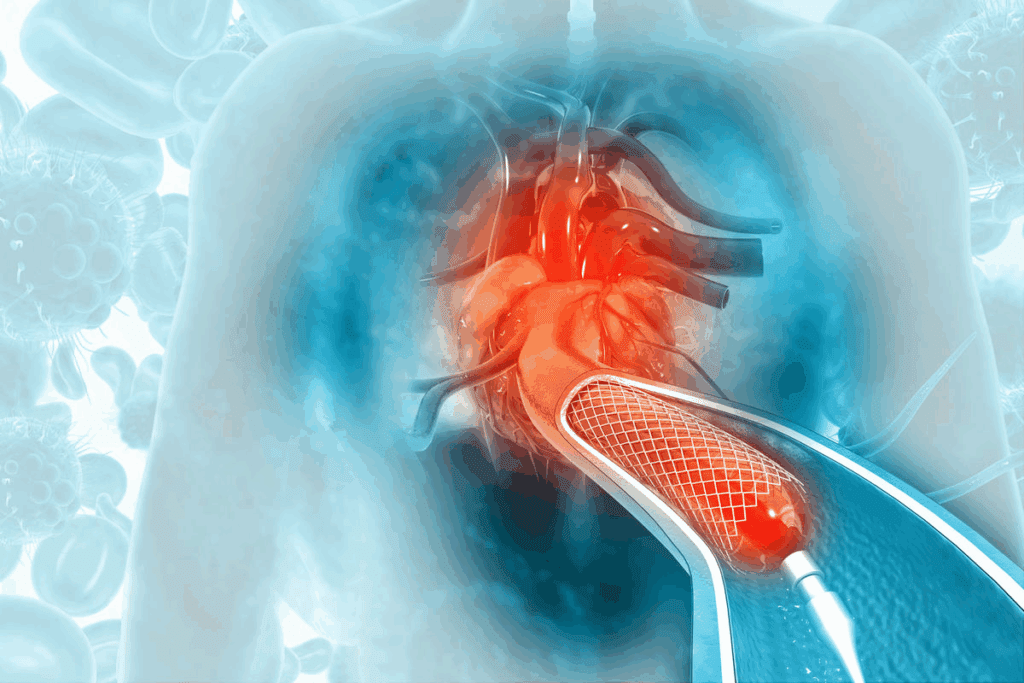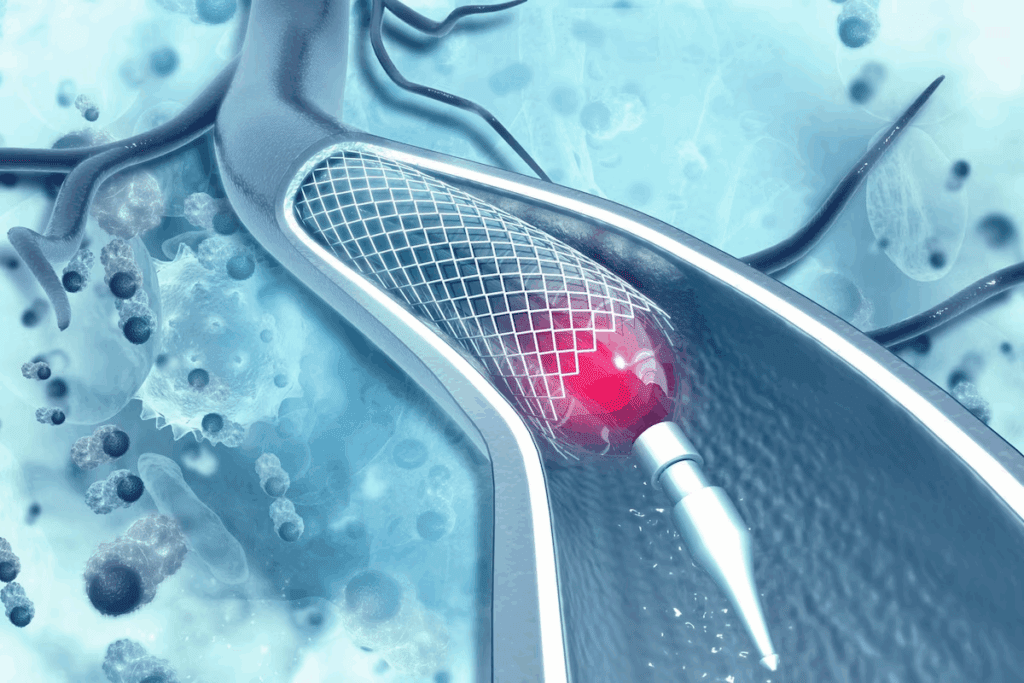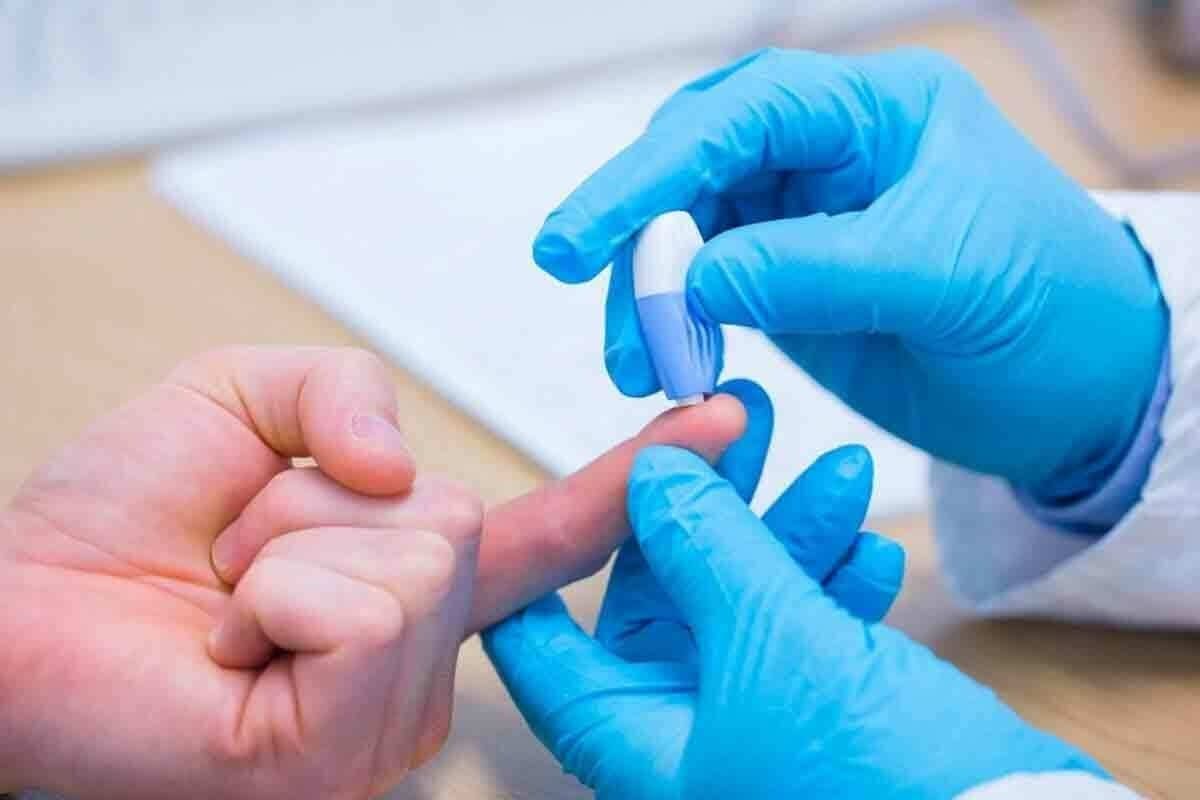Last Updated on November 26, 2025 by Bilal Hasdemir

At Liv Hospital, we know how important clear information is in medical care. A stent is a small, tube-shaped device. It keeps narrowed or blocked blood vessels open, helping blood flow normally.
These tiny mesh tubes are made of metal or polymer. They are put into a blood vessel to help blood or other fluids flow. For people with blocked coronary arteries, a stent can be a game-changer.
We use simple language to talk about stents. This includes what they look like and what they do. We want our patients to understand their care options well.
Learn the define stent, meaning, and medical uses of a stent explained clearly.
Key Takeaways
- A stent is a small, tube-shaped medical device.
- Stents are used to keep narrowed or blocked blood vessels open.
- They are typically made of metal or polymer.
- Stents help restore normal blood flow.
- They are often used to treat blockages in coronary arteries.
Understanding Stents: Basic Definition and Purpose

To grasp the importance of stents in medicine, we need to know what they are and why they’re used. A stent is a small, mesh-like tube. It keeps blocked or narrowed passages open, ensuring normal flow.
What Exactly Is a Stent?
A stent is a short, narrow metal or plastic tube, often mesh-like. It’s placed in the lumen of a vessel to keep it open. The correct spelling is s-t-e-n-t, and it’s pronounced as ‘stent.’ They’re used in arteries, veins, or other vessels to improve blood flow and prevent re-narrowing after angioplasty or other interventions.
Primary Functions of Stents in Medicine
The main roles of stents in medicine are:
- To keep blood vessels or other passages open, ensuring normal flow and preventing re-narrowing.
- To support the walls of vessels or ducts, mainly after angioplasty or other interventions.
- To enhance blood flow to certain body areas, easing symptoms from blocked or narrowed vessels.
By doing these things, stents are a key tool in many medical fields, most importantly in cardiovascular medicine.
The Etymology and Correct Spelling of “Stent”

The word “stent” has a fascinating history in medical terms. It comes from the field of medicine. Knowing its origins helps us understand how to spell and use it correctly.
Origin of the Term “Stent”
The name “stent” comes from Charles Thomas Stent, an English dentist from the 19th century. He created a compound for dental impressions. This idea later helped in medical procedures to support tissues.
Today, “stent” means devices that keep arteries and other passages open. Its spelling and meaning have become clear in medical talk.
Common Spelling Mistakes: Is It “Stint” or “Stent”?
Many people mix up “stent” and “stint.” “Stint” means a time period or a limit on doing something. But “stent” is a medical tool for keeping passages open.
So, stent is the right word for the medical device. It’s spelled S-T-E-N-T.
| Term | Definition | Example |
| Stent | A medical device used to keep arteries and vessels open. | “The doctor placed a stent in the patient’s artery.” |
| Stint | A period of time spent doing something or a limitation. | “She worked a stint at the hospital before moving abroad.” |
It’s important to know the difference between “stent” and “stint” in medical talk. Knowing the right spelling and meaning of “stent” helps everyone communicate clearly and accurately.
How to Define Stent in Medical Terminology
Stents are important medical tools. They help keep blood flowing by opening up blocked areas in the body. This is key for keeping blood and other fluids moving.
Clinical Definition and Classification
A stent is a small, tube-like device. It’s made of metal or synthetic materials. It’s placed in a body vessel to stop blockages.
Stents come in different types. They’re classified by what they’re made of. This includes bare-metal stents, drug-eluting stents, and bioresorbable stents.
Knowing how to classify stents helps us understand their uses. Here’s a quick look at the main types and what they’re for:
| Type of Stent | Material | Primary Use |
| Bare-Metal Stent | Metal mesh | Coronary arteries |
| Drug-Eluting Stent | Metal mesh with drug coating | Coronary arteries, reducing restenosis |
| Bioresorbable Stent | Biodegradable material | Coronary arteries, temporary support |
Pronunciation Guide for Medical Professionals
The word “stent” is pronounced /stɛnt/ (STENT). It’s important for doctors and nurses to get it right. This ensures they can talk clearly with patients and colleagues.
It’s key for healthcare workers to know about stents. By understanding their types and uses, doctors can give better care. They can also explain treatments clearly to patients.
The Meaning of Stents in Different Medical Contexts
Stents are used in many medical areas, not just the heart. They help improve blood flow and fix damaged areas in the body. This is true for many parts of the body.
Stent Meaning in Cardiovascular Medicine
In heart medicine, stents are key for treating blocked arteries. Stent placement helps millions each year. It makes it easier for blood to reach the heart, easing pain and breathing issues.
Cardiovascular stents are made to last and fit well with the body. Drug-eluting stents are special because they release medicine to keep arteries open.
Stent Meaning in Other Medical Specialties
Stents are also used in other fields. In urology, they fix urinary blockages. In gastroenterology, they help with esophageal or bile duct issues. Stents are very flexible and can help with many problems.
Stents are vital in many medical areas. Knowing how they work helps doctors give better care. This makes treatment plans more effective for each patient.
Anatomical Applications: Where Stents Are Used
Stents are key in modern medicine, used in many parts of the body. They help keep blood flowing by opening up blocked or narrowed vessels. This is done to treat various medical conditions.
Choosing and placing stents has greatly improved patient care. Today, we have different types of stents. These include bare-metal, drug-eluting, and bioresorbable stents. Each type is designed for specific needs and conditions.
Coronary Arteries: The Most Common Application
Stents are most often used in the coronary arteries. They are vital in treating coronary artery disease (CAD). CAD happens when the arteries that supply blood to the heart get narrowed or blocked.
Coronary stenting involves placing a stent in the artery. This keeps it open and ensures blood flow to the heart. The procedure is usually done during an angiogram and is called percutaneous coronary intervention (PCI).
Non-Coronary Applications in the Body
Stents are also used in other parts of the body. They treat conditions like peripheral artery disease, carotid artery stenosis, and more. This includes vessels other than the coronary arteries.
Some non-coronary uses of stents include:
- Peripheral artery disease (PAD) treatment
- Carotid artery stenting to prevent stroke
- Renal artery stenting to improve kidney function
- Iliac artery stenting for lower limb ischemia
The table below shows where stents are used and their benefits:
| Anatomical Location | Condition Treated | Benefit of Stenting |
| Coronary Arteries | Coronary Artery Disease (CAD) | Restores blood flow to the heart |
| Peripheral Arteries | Peripheral Artery Disease (PAD) | Improves limb perfusion and reduces pain |
| Carotid Arteries | Carotid Artery Stenosis | Reduces risk of stroke |
| Renal Arteries | Renal Artery Stenosis | Improves kidney function and controls hypertension |
Types of Stents and Their Specific Functions
Stent technology has greatly improved how we treat heart diseases. With new stent types, doctors have more options to meet each patient’s needs.
Stents are mainly divided into three types: bare-metal, drug-eluting, and bioresorbable. Each has its own role and benefits.
Bare-Metal Stents: Structure and Use Cases
Bare-metal stents are the first kind made of metal mesh. They help keep arteries open after a procedure. But, they might cause the artery to narrow again more often than newer stents.
A study in the Journal of the American College of Cardiology shows bare-metal stents are less used now. This is because drug-eluting stents work better at preventing artery narrowing.
“The use of bare-metal stents has declined significantly with the advent of drug-eluting stents, which have shown superior outcomes in reducing restenosis.”
Drug-Eluting Stents: Advanced Benefits
Drug-eluting stents release medicine slowly into the artery wall. This greatly lowers the chance of the artery narrowing again. They are now the top choice for many patients needing stenting.
| Stent Type | Restenosis Rate | Primary Benefit |
| Bare-Metal Stents | 20-30% | Structural support |
| Drug-Eluting Stents | 5-10% | Reduced restenosis |
Bioresorbable Stents: The Future of Intervention
Bioresorbable stents are made to dissolve in the body over time. They support the artery while it heals and then disappear.
Key benefits of bioresorbable stents include:
- Restoration of normal artery function
- Potential for improved long-term outcomes
- Elimination of long-term foreign body presence
Medical Expert, a top cardiologist, says bioresorbable stents are a big step forward. They could lead to better healing and fewer long-term problems.
Choosing the right stent and placing it correctly greatly helps patients. With new stent technologies, doctors keep getting better at treating heart conditions. This leads to better care and a better life for patients.
The Stent Placement Procedure Explained
Our team at Liv Hospital is committed to making every stent placement procedure safe and precise. We know it can be scary, so we’re here to help you understand what to expect.
Preparation and Patient Considerations
Before the stent placement, we carefully check each patient. We look at their medical history, the blockage’s severity, and their overall health.
Patients are told what to do before the procedure. This includes:
- Stopping certain medications that may interfere with the procedure
- Fasting for a specified period before the procedure
- Arranging for someone to drive them home after the procedure
Step-by-Step Procedure Overview
The stent placement procedure has several important steps:
- Administering local anesthesia to numb the area where the catheter will be inserted
- Inserting a catheter into the blocked artery through a small incision
- Using X-ray imaging to guide the catheter to the correct position
- Inflating a balloon to open the blocked artery
- Placing the stent to keep the artery open
Recovery and Post-Procedure Care
After the stent procedure, patients are watched for a few hours. Most can go home the same day or the next, depending on their health.
Recovery after stent placement means:
- Resting for the remainder of the day
- Avoiding heavy lifting and strenuous activities for a few days
- Following a heart-healthy diet and lifestyle
- Taking prescribed medications to prevent blood clots and manage other conditions
At Liv Hospital, we stress the need for follow-up care. We want to make sure the stent works well and catch any problems early.
Global Impact: Statistics and Significance of Stent Procedures
Every year, over 2 million stent procedures are done worldwide. This has a big impact on healthcare. Stents help manage heart diseases and save lives. They also affect healthcare budgets.
Worldwide Usage: Over 2 Million Procedures Annually
Stent procedures are key in treating heart disease. Over 2 million people worldwide get stents each year. This shows how important stents are in medicine.
The global stent market is growing. This is because more people are getting older and heart diseases are more common. Stents are becoming more vital in healthcare.
“The use of stents has revolutionized the treatment of coronary artery disease, making it less invasive and more beneficial for patients.”
— Medical Expert, Interventional Cardiologist
Economic and Healthcare System Impact
Stent procedures have big economic effects. They can be expensive at first but save money in the long run. They help avoid more costly treatments and reduce recovery times.
| Region | Number of Stent Procedures (Annual) | Estimated Healthcare Cost Savings |
| North America | 800,000 | $1.2 billion |
| Europe | 700,000 | $1.0 billion |
| Asia-Pacific | 500,000 | $800 million |
The numbers show stent procedures save a lot of money worldwide. They help avoid long hospital stays and reduce complications. This leads to big savings in healthcare costs.
As medical technology improves, stents will likely play an even bigger role. They will help more patients and save healthcare systems even more money.
Risks and Complications Associated with Stents
Stents have greatly improved patient care, but they come with risks. It’s important for patients to know about these complications. This knowledge helps in managing the risks better.
Short-Term Complications to Be Aware Of
Right after a stent is placed, patients might face bleeding at the catheter site. They could also have allergic reactions to the contrast dye used. Another risk is blood clots forming within the stent.
These clots, called thrombosis, can cause heart attacks or strokes. To avoid this, doctors often prescribe antiplatelet therapy. They also keep a close eye on patients after the procedure.
Long-Term Considerations for Patients with Stents
Over time, patients might face restenosis or in-stent restenosis. These issues can cause blockages again. But, drug-eluting stents have made these risks lower by preventing tissue growth.
To stay safe, patients should eat well, exercise, and not smoke. Regular check-ups with their doctors are also key. This helps keep the stent working well and the heart healthy.
Knowing the risks and taking steps to prevent them can greatly improve outcomes. It’s a team effort between patients and doctors to manage these risks well.
Conclusion: The Evolving Role of Stents in Modern Medicine
Medical technology keeps getting better, and so does the role of stents. They are changing how we care for patients and the results we see. From simple to more advanced types, each stent brings new benefits and better health outcomes.
The future of stents looks bright, with scientists working hard to make them safer and more effective. As stents play a bigger part in medicine, we expect to see even more effective treatments for people everywhere.
Stents are now key in treating many health issues, not just heart problems. We’re excited to see how new stent technologies will keep improving medical care. This will help patients all over the world.
FAQ
What is a stent?
A stent is a small, mesh-like device. It keeps blood vessels or other passages open. This ensures blood flows properly and reduces blockage risks.
How do you spell stent?
The correct spelling is S-T-E-N-T. It’s often mixed up with “stint,” but “stent” is a medical device term.
What is the difference between “stent” and “stint”?
“Stent” is a medical device to keep vessels open. “Stint” means a short time doing something or a task given. They sound alike but mean different things.
How is the term “stent” pronounced?
“Stent” is pronounced as /stɛnt/ (STENT).
What are the primary functions of stents in medicine?
Stents keep blood vessels open and improve blood flow. They also reduce blockage risks. They’re mainly used in heart medicine but also in other areas.
What are the different types of stents available?
There are many stent types, like bare-metal, drug-eluting, and bioresorbable stents. Each has its own benefits and uses.
What is the stent placement procedure like?
The procedure starts with preparation and then the stent is inserted step by step. After, there’s post-procedure care. Patients are told about these steps and any needed precautions or follow-up.
What are the risks and complications associated with stents?
Stents can cause short-term issues like bleeding or infection. Long-term, there’s a risk of restenosis or stent thrombosis. It’s important for patients to know these risks and talk to their doctor.
How are stents used in different medical contexts?
Stents are used in heart medicine to treat coronary artery disease. They’re also used in other areas to treat different vascular conditions.
What is the global impact of stent procedures?
Stent procedures are done over 2 million times a year worldwide. They have a big impact on healthcare and patient outcomes.
What does the future hold for stent technology?
The future of stent technology is promising. There are new materials, designs, and functions being developed. Bioresorbable stents are a big step forward in heart care.
References
- National Heart, Lung, and Blood Institute. (2023, November 29). What Are Stents? NHLBI. https://www.nhlbi.nih.gov/health/stents






